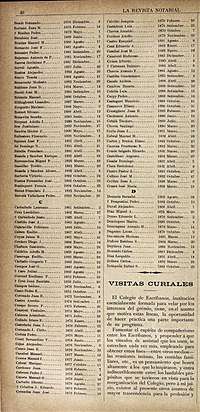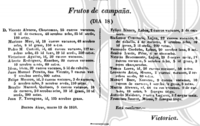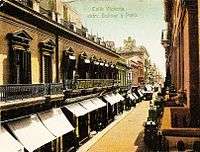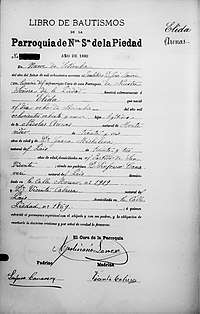Sinforoso Canavery
Sinforoso Canavery (1857 – c. 1938) was an Argentine jurist, who served as a notary public in the cities of Buenos Aires and La Plata,[1] and as Notary Mayor of Government of Buenos Aires Province towards the end of the 19th century.[2] He had an active participation in public contracts of the province of Buenos Aires, where he served for more than thirty years. His works as a notary, also includes his participation in the deeds of The Tramway Rural.[3]
Sinforoso Canavery | |
|---|---|
| Escribano Mayor de Gobierno of Buenos Aires Province | |
| In office ? – ? | |
| Preceded by | ? |
| Succeeded by | ? |
| Titular del Registro de Contratos Públicos N° 1 La Plata In office 1886-1887 1903-1929 | |
| Preceded by | ? |
| Succeeded by | ? |
| Personal details | |
| Born | Sinforoso Máximo Canavery Páez October 3, 1857 Buenos Aires |
| Died | c.1938 Adrogué, Buenos Aires |
| Resting place | La Chacarita cemetery |
| Nationality | |
| Spouse(s) | Angélica Fortunata de Andrade |
| Children | Moisés Leocadio Canavery Miguel Ángel Canavery Angélica Nefer Canavery Emma Canavery d'Alvarado Périchon (goddaughter) Elida Arenas Michelena (goddaughter) |
| Occupation | government |
| Profession | notary |
| Signature | |
He belonged to a distinguished family of Buenos Aires and Montevideo politically related to the Federal and National Party. His father participated in the Argentine and Uruguayan Civil War, serving as 1st lieutenant in the Baballón de Rebajados de Buenos Aires in support of the forces of Manuel Oribe, during the Gobierno del Cerrito.[4]
Biography

He was born in the neighborhood of Monserrat, Buenos Aires, son of Sinforoso Camilo Canaverys and Quintina Páez, belonging to a family of French-Piedmontese and Iberian ancestry. His grandfather Manuel Canaverys, was a Lieutenant of the Regimiento de Patricios, who toke part in the defense and reconquist of the city during the English Invasion, and who also participated in the donations for the First Upper Peru campaign in 1810.[5]
Sinforoso Canavery attended primary school in his native neighborhood and completed his secondary education in at National School of Buenos Aires for the year 1875. He obtained his title of Notary Public in the Colegio de Escribanos of Buenos Aires Province on December 1, 1883.[6] He began his career as notary of the Province of Buenos Aires in the government of Carlos Alfredo D'Amico. He served in the city of La Plata in 1886-1887-1889-1894, and from December 1, 1900, until his last performance as notary in that city on May 25, 1929, during the government of Valentín Vergara.
Canavery was a pioneer in the notary offices installed in the rural areas of the Province of Buenos Aires, in 1903, during the governorate of Marcelino Ugarte he served for a brief period as a notary of the 1st Registry of Public Contracts of the city of Navarro.[7]
In 1885 The Sociedad Anónima Teatro Argentino purchased a plot of land from the Government of the Province of Buenos Aires, located in the city of La Plata (event carried out before the notary Sinforoso Canavery).[8]
He participated in the notarial acts of distinguished personalities of the French Society of Buenos Aires. His performances as notary of Government include the contracts for sale of land of Claudio María Joly (born Saône-et-Loire) to Federico Lacroze, owner of Buenos Aires Central Railway.[9] In 1902, he made the scriptures of the sale of a farm in Pehuajó,[10] property of Mirant Borde, known lawyer of French origin.[11] He also performed the deeds of a mortgage between the Banco Español del Río de la Plata and Francisco Cayol Kerkis,[12] son of Bartolomé Cayol, born in Toulon.[13]
He is also found in an old register with Emmanuelle Bousquet, a well-known French entrepreneur, in the contracts between the government of the province of Buenos Aires and the railway entrepreneur Rodolfo Giménez. In a failed project for the construction of a railway from La Plata to Veinticinco de Mayo, and that it would cross the towns of San Vicente, Cañuelas, Gral. Zapiola (Lobos), Chivilcoy. And a railway branch from Navarro to Mercedes and Carmen de Areco to finish its route in the town of Salto.[14]
Canavery also took part in the notarial acts of Argentine politicians and military like Colonel Julián Martínez Lerena and General Zacarías Supisiche, in the sale and purchase of 27,000 hectares to the Mallman Company.[15] In 1888, he made the transfer documents of a property between Nicolás Levalle and Florencio Monteagudo, two well-known Argentine military.[16] In 1890, Canavery performs the notarial deed of a field in the city of Las Heras between Juan Bossio and Máximo Paz. A failed sale that ended in a trial of Bossio against Máximo Paz (politician and hacendado of Buenos Aires).[17]
In 1918 he made the deeds for the purchase of a property made between Pedro Bercetche to Alfredo Demarchi, a former vice-governor of the province of Buenos Aires.[18]
He also served as a notary of the Government of the City of Buenos Aires, in charge of the registration office 29, with jurisdiction in Balvanera and Almagro. He was appointed head of the office number 70 by decree of the President José Evaristo Uriburu in 1897.[19] He resigned his post in 1900,[20] after the then President Julio Argentino Roca appointed Alejandro Ferrari as co-holder of the Registry of Public Contracts No. 70.[21]
Canavery was part in the foundation of some notarial offices of the city of Buenos Aires, including Belgrano and Flores. On October 7, 1887, he had been present in the Ministry of Justice, calling for the creation of an Office of Registration of civil contracts. His request was approved by the Supreme Court of Argentina.[22]
He also had an active participation as a notary public of the city and the province of Buenos Aires,[23] including the notarial acts of former residences belonging to the local aristocracy.[24] One of its offices was located on Avenida de Mayo No. 1261,[25] a few blocks from the Plaza Lorea, neighborhood of Monserrat.[26] He also installed his offices in the neighborhood of San Nicolás, on a building located on Avenida Rivadavia No. 563,[27] in the vicinity of the Cathedral of Buenos Aires.
In La Plata, Capital of the Province of Buenos Aires, he had several public offices, including on the Avenida 51, No 1278, near of the Cathedral of La Plata.[28]
Sinforoso Canavery not only dedicated himself to notarial tasks in the city. In 1887, he offered his free services as commissioner of the 8th section in the census of population, building, commerce and industries of Buenos Aires, conducted between August 17 and September 30 of that year.[29]
Sinforoso Canaverys


His father Sinforoso Camilo Canaverys (1808-1872), baptized with those names in honor of Symphorosa and Camillus de Lellis, was a Federal military man,[30] who took part in the Argentine and Uruguayan Civil War, serving in the Batallón de Voluntarios Rebajados de Buenos Aires, a military unit formed by veterans of the federal army.[31] He served under Colonel Joaquín Ramiro, taking part in various Argentine military campaigns, including the Campaña de Rosas al Desierto and Great Siege of Montevideo.[32]
He also dedicated himself to rural tasks in the Province of Buenos Aires, taking part in the trade of hides, suet and antlers to supply the city of Buenos Aires. He is registered in several editions of the newspaper El Lucero in 1833.[33]
He was married three times, first to Manuela Pelliza, daughter of Francisco Pelliza and María Fernández, belonging to a distinguished family of creole roots. This marriage, whose registry has the signature of Feliciano Pueyrredón, was carried out on August 17, 1826, in the Parroquia de Santos Lugares.[34]
He was the father of Francisco María Canavery Pelliza (1827-1861),[35] a lieutenant who took part in the Revolution of 11 September 1852, and in the defense of Buenos Aires during the siege of Hilario Lagos.[36]
His second wife was Rosa Farias Zubillaga, daughter of Francisco Higinio Farias and Josefa Juliana Zubillaga, belonging to a family in Montevideo related to José Brito del Pino. He and his wife were parents of Isabelino Canaveris, a Uruguayan patriot, who participated in the Revolución of 1897.
His last marriage was with Quintina Páez, born in 1830 in Montevideo and deceased in Buenos Aires on July 9, 1881.[37] He and his wife lived in the Barrio Unión, Montevideo,[38] and were present in Buenos Aires when the railroad was inaugurated in 1857.
He and his family made frequent trips on board the Vapor Marquês de Olinda and other known ships, that connected the Port of Buenos Aires with to Montevideo. He settled permanently in Buenos Aires in 1860, owning a Barraca de frutos (warehouse) on Calle de la Victoria No. 614, in the commercial area of Monserrat.[39]
He was a great-grandson (maternal line) of Joseph Antonio Calderón de la Barca and Margarita Taborda, belonging to ancient creole families, descendants of the Spanish conquerors of Chile and Antioquia. His grandsons Saturnino Canavery and Héctor Canavery, participated in the Conquest of the Desert.
Sinforoso Camilo Canaverys was an active militant of the Partido Blanco in the Banda Oriental. He died on May 9, 1872, aged 63.[40]
Family


Máximo Sinforoso Canavery Páez, born in 1857 during the period of State of Buenos Aires, was baptized in the Parish Nuestra Señora de Montserrat on March 10, 1858, being his godmother his aunt Ruperta Canavery. His baptismal record bears the signature of Manuel Velarde, priest of the parish.[41]
He lived in different historic neighborhoods of the city of Buenos Aires, including Balvanera, where he rented a house located on calle Rincón No. 82, a few meters from the current Plaza Primero de Mayo.[42] His natal house was leased by his father to José Manuel Estrada, owner of the barracks on Victoria Street No. 614,[43] located in the vicinity of the Club del Progreso, Teatro de la Victoria and the store A la Ciudad de Londres.[44]
He also lived or was linked to the cities and towns of Adrogué, Temperley, Llavallol, Banfield and La Plata, where he was a neighbor of Esteban F. Achinelly Thompson, a relative and colleague who built the Palacio Achinelly.[45]
He was married on April 19, 1894 in the Parish Nuestra Señora de Balvanera to Angélica Fortunata Andrade, daughter of Juan Manuel de Andrade and Domitila Alegre, belonging to a family of landowners dedicated to raising livestock in the area of San Vicente and Cañuelas in Buenos Aires Province.
His wife, born on January 9, 1877 in Monserrat, belonged to distinguished Portuguese families of Lisbon and Porto, and descended from illustrious Creole lineages related to conquistadores, and also of Spanish aristocratic families from El Puerto de Santa María and Seville, linked in turn to families Monterroso-Rueda, Piña-Merlos, Bourré, Vega-Soreyra and Belgrano-Rico. She was a great-granddaughter of Casimiro Alegre, a military man and landowner who served as campaign mayor in the Province of Buenos Aires.
Juan Francisco de Andrade, grandfather of Angélica, was an immigrant, born in the times of the Peninsular War in Praça de Santo Ovídio.[46] He arrived in Argentina during or after the Portuguese Civil War, and established in the Province of Buenos Aires by 1835, where he was dedicated to cattle breeding, being the owner of a hacienda, built of adobe and straw, located in the area of Cañuelas.[47] He passed away on August 6, 1869 in Buenos Aires,[48] and was buried in the Cementerio del Norte.[49]
Canavery and his wife were relatives to the families Reynolds-Newton from London. He through Blanca Canaveris (b.1912), the wife of Saturnino Soriano Newton, and Angélica Andrade, through his great grandparents José Martínez Gulivert, born by 1715 in Valencia and María Muñoz Salinas, maternal ancestors of Francisco Reynolds.[50]
Sinforoso Canavery had several brothers, including Camilo Alejo Canavery (godson of José Antonio Durán), a lawyer who participated in the Revolution of the Park under José Camilo Crotto,[51] and who served as secretary of the Capital Committee of the Radical Civic Union, chaired by Carlos Vega Belgrano.[52] His work as a lawyer includes services to Crotto, and his participation in the trial against The Atlas Assurance Company, an English insurance company established in Buenos Aires.[53]
He was the godfather of Emma Cipriana Canavery, related to families Rouquaud Périchon,[54] and Elida Arenas, related to Lieutenant Colonel Juan Ángel Michelena (uncle of Sinforoso),[55] a patriot who served in the War of Independence, under General José de San Martín.[56]
His ancestors Francisco Pérez de Burgos and Gonzalo Carbajal, had a preponderant role in the beginnings of the political and military life of the Río de la Plata.[57] His wife was the descendant of several soldiers who served in the Spanish Army during the reign of Philip V of Spain, including Francisco Muñoz[58] and Gerónimo de Vieyra, alférez and artillero, of the Fuerte de Buenos Aires towards the beginning of the 18th century.[59]
References
- Tierra de pioneros: junto a la Zanja de Alsina, Carlos Barrios Barón
- Acuerdos y sentencias dictados por la Suprema Corte de Justicia de la Provincia, Buenos Aires (Argentina : Province). Suprema Corte de Justicia, 1918
- Partido General Sarmiento, San Miguel Imp. de Pablo E. Coni é hijos
- El gobierno del Cerrito: pte. 1-2 Poder legislativo; actas...y documentos, Uruguay, Presidente, 1843-1851 (Oribe), 1948
- Documentos para la historia del general don Manuel Belgrano, Volumen 3,Parte 1, Instituto Belgraniano Central (Buenos Aires, Argentina), 1982
- La revista notarial, Colegio de Escribanos de la Provincia de Buenos Aires, (October 1, 1884)
- datos de la actuación, Colegio de Escribanos Provincia de Buenos Aires
- Revista de la Universidad, Volume 29, Universidad Nacional, 1984
- La municipalidad y el ferro-carril de Buenos Aires al Pacífico, Ernesto Quesada
- Acuerdos y sentencias dictados por la Suprema Corte de Justicia de la Provincia, Buenos Aires (Argentina : Province). Suprema Corte de Justicia
- Jurisprudencia de los tribunales nacionales, Argentina. Courts
- Gaceta del foro: jurisprudencia, legislación, doctrina, Volume 3, Argentina, 1916
- Profundización de los aspectos estéticos de petroglifos y pictografías de la Provincia del Neuquén, Universidad Nacional del Comahue. Facultad de Turismo, 1998
- Leyes, contratos y resoluciones referentes á los ferrocarriles y tranvías á tracción mecánica de la Republica Argentina, Volume 5, República Argentina, 1904
- América: orígenes y recuerdos, 1880-1930, Alberto Federico Orga - Editorial Universitaria de Buenos Aires
- Archivo histórico Olavarría, Volumen 1, Parte 1, Municipalidad de Olavarría, 1986
- Fallos de la Corte Suprema de Justicia de la Argentina, Argentina
- Diario de sesiones de la Ca mara de Diputados, Argentina. Congreso de la Nación. Ca mara de Diputados de la Nación, 1920
- Boletín Oficial de la República Argentina. 1897 1ra sección, República Argentina
- Consulta de Actuación de Escribanos, Colegio de Escribanos de la Ciudad de Buenos Aire
- Boletín Oficial de la República Argentina. 1900 1ra sección, República Argentina
- Memoria presentada al H. Congreso Nacional, correspondiente al an o de ..., por el Ministro de Justicia e Instruccio n Publica, Congreso Nacional Argentino (1888), OCLC 41539288
- La Rural; guia general de estancieros de la republica confeccionada para los miembros de las sociedades rurales argentinas, 1912, 1912
- Antiguas quintas porteñas, Carlos A. Rezzónico, January 1996
- Anuario de la América latina(Bailly-Baillière-Riera), Anuarios Bailly-Baillière y Riera
- Trade Directory of South America for the Promotion of American Export Trade, United States. Bureau of Foreign and Domestic Commerce, 1914
- Anuario del comercio, de la industria, de la magistratura y de la administración, Hemeroteca Digital
- Nuestro mundo, Números 75-98, Nuestro Mundo, 1927, 1927
- Censo general de población, edificación, comercio é industrias de la ciudad de Buenos Aires..., Compañia Sud-Americana de Billetes de Banco 1889
- Indice del Archivo del Departamento general de Policía, Buenos Aires - Departamento de Policía - Archivo
- Revista del Instituto Nacional de Investigaciones Históricas Juan Manuel de Rosas, Números 54-57, Instituto Nacional de Investigaciones Históricas Juan Manuel de Rosas, 1999, 1999
- Historia política y militar de las repúblicas del Plata, Antonio Díaz, 1878
- Frutos de campaña (PDF), El Lucero
- Matrimonios 1825-1900, Jesús Amoroso
- Aportes biogenealógicos para un padrón de habitantes del Río de la Plata, Volumen6, Fernández Burzaco, 1991
- Ensayo histórico de la defensa de Buenos Aires:, José Luis Bustamante
- Defunciones 1880-1881, Parroquia Nuestra Señora de Balvanera
- Uruguay, Montevideo, censos, 1726-1860, Archivo General de la Nación (Montevideo, Uruguay)
- Diccionario de Buenos Aires, ó sea guia de forasteros, Buenos Aires, 1864
- Defunciones 1872-1873, Nuestra Señora de Balvanera
- Bautismos 1856-1859, Parroquia Nuestra Señora de Montserrat
- Bautismos 1883, Nuestra Señora de Balvanera
- Contribucion directa. Rejistro de los contribuyentes de la ciudad de Buenos Aires, Buenos Aires, 1870
- Historia cronológica de la ciudad de Buenos Aires 1536-2014, Contreras, Leonel, March 2014, ISBN 9789870273066
- Palacio Achinelly, Art Nouveau World
- Bautismos 1851-1856, Nuestra Señora del Carmen
- Argentina, Capital Federal, Census, 1855, Argentine Confederation
- Defunciones 1869-1870, FamilySearch
- Defunciones, El Río de la Plata (August 10, 1869)
- Boletín del Instituto Argentino de Ciencias Genealógicas, Tema 180, Instituto Argentino de Ciencias Genealógicas, 1993, 1993
- Crotto: historia de una ingratitud, Editorial Armerías, 2004, 2004
- Por la patria: La revolución de 1897 y sus antecedentes, Luis Alberto de Herrera
- Jurisprudencia de los tribunales nacionales: Publicación dirigida por la Inspección general de justicia, Argentina. Courts, 1914
- Bautismos 1883, Nuestra Señora de Balvanera
- Bautismos 1890-1891, Parroquia Nuestra Señora de la Piedad
- Notas biográficas publicadas en la sección Efemérides americanas de "La Nación": en los años 1907-1909, José Arturo Scotto, 1910
- Genealogía, Issues 13-15, Instituto Argentino de Ciencias Genealógicas, 1961
- Protocolos : Registro No. 1, 1757-1799, Archivo General de la Nación Argentina, 1993
- Protocolos, 1584-1756, Archivo General de la Nación Argentina